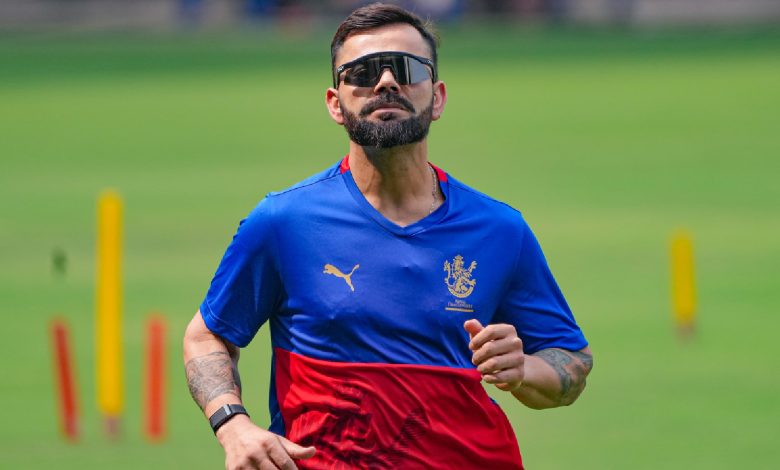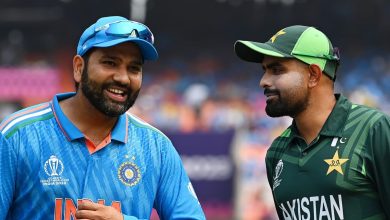Virat Kohli should be in India’s T20 World Cup squad, even if he has a middling IPL season | Ipl News

Ever since Virat Kohli returned to India, even the minutest detail about the 35-year-old has found its way to social media. That he spotted a salt-and-pepper beard when he arrived at the Bangalore Airport; that he wore baggy black t-shirts, or he lunged to his left and then sprung to his right during a fielding drill.Suddenly, the narrative that Kohli needs a profitable IPL to guarantee his spot in the T20 World Cup, which begins a week after the league, has vanished.
Such a thought was ludicrously to begin with.
True that Kohli is not a super-modern batsman in this format and that a posse of incredibly talented youngsters has staked their claims. But the simple reality is that he remains undroppable in any version of the game. It’s not because of his stature, or the grand past, or the commercial pull of his face splashed on New York skyscrapers. But because he still matters when he has a bat in hand.
There could be more enterprising batsmen. He is not an improvisational genius as Suryakumar Yadav is. He might not be as nonchalant a hitter as Hardik Pandya. But in some ways, he continues to be the team’s heartbeat, their biggest match-winner still in this format.
It’s a simple but instructive number. Of the 109 times he has batted in T20 Internationals, India have won on 70 occasions.
In those outings, he has scored 2828 runs at 67.33; 15 times he was the man of the match.
He is still the unparalleled chase-master. He averages 71.85 when chasing, with a healthy strike rate of 137. The nearest competitor from a top-10 nation is Suryakumar Yadav (50.12) but with a better striking rate of 159. In 46 chases when Kohli has batted, India have won 40. In those games, he averages 86.84. The strike rate is around his mean — 136 to the overall 138. And 18 times, he has remained undefeated. None more memorable than the unbeaten 82 against Pakan in Melbourne during the T20 World Cup.
But that knock, freakish as it is tempting to say, was not an outlier.
Often forgotten, among other knocks, are his 82 not out (SR of 160) against Australia in Mohali and 55 not out (140) against Pakan in Kolkata in the T20 World Cup.
His strike rate has often been projected, myopically, as his T20 Achilles’ heel. While 138.15 is not a superhuman number, it’s not middling either. Rohit Sharma’s is just a notch above, at 139.97; Pandya’s is 139.8. Chris Gayle struck at 137.50; Alex Hales at 138. When assessing Kohli’s strike rate, one has to consider his role too.
Team’s batting axis
Oftentimes, his primary duty has been to drag his team through the middle overs, to keep the run-rate moving along with supreme field manipulation, and the occasional boundary-hitting. It’s what makes him fearful for opposition captains. You can stop neither singles or stem the flow of singles and twos. And at the death, he would turn on beast mode. He would straddle roles as only a few others could. Kohli could not improvise like Suryakumar. But Suryakumar could not be the team’s axis like Kohli could be.
Every successful team had one. When West Indies tore the T20 perception with big-hitting in 2016, they still required the stability of Marlon Samuels (SR of 112 in the tournament). Australia hinged on David Warner’s consency (SR of 146). England’s batting bulwark Jos Buttler hit at 144. Both were openers too, and hence an understandably better hitting rate.
Another myth: That he doesn’t hit as many boundaries as the format demands. He finds a four or six every 6.1 balls. Rohit’s corresponding number is 6.3. Among his batting colleagues, who have played at least 20 games, only Yadav has a better boundary-striking ratio (3.9).
The root cause of India’s supposed sluggishness at the top was not Kohli in isolation. But a top three that batted at a similar tempo (SR of 138-140), who took time to rev up, was the malaise of India in the last two World Cups.
That, though, would change. Rohit has embraced a more carefree approach, as he has displayed in the 50-over World Cup, where the new mantra is to treat the format like a stretched out version of T20s rather than the other way around. Rohit’s partner would be one of Yashasvi Jaiswal (it solves the left-hander issue) or Shubman Gill. Jaiswal especially likes to start finding the boundaries from the start. All these changes would benefit Kohli.
Unshackled approach
The master batsman himself has not resed change either. He has made a conscious effort to lift his strike in the past few years. In the last 14 games for his country, he has hit his runs at 146.31, with a fifty plus score in every two and half innings.
A boundary has been eked out of every 5.3 balls too. He has unshackled his game too — he steps out of the crease, especially to the seamers, more often. He attempted a few cute paddle sweeps last year, and was not shy to slog the spinners.
Last IPL, his second most prolific season, he said, was his most enjoyable as a batsman. “A lot of people feel my T20 cricket is declining, but I don’t feel like that at all. I feel I am playing my best T20 cricket again. I look to hit gaps, hit a lot of boundaries and the big ones in the end if the situation allows me to.”
The more time he spends at the crease, the better his strike rate turns out to be. He has faced 27 or more balls 51 times in T20Is. On 18 of those occasions, he scored at 150-plus. Eight times, he maintained between 140 and 150.
In that sense, Kohli is a partly misunderstood T20 cricketer. Some of his colleagues, like Rohit, cannot fathom this scrutiny. “I don’t even understand why they are called experts,” he jibed to a reporter last year.
Maybe, it’s because Kohli has never won a T20 trophy, neither IPL nor World Cup.That then should be the narrative arc of Kohli before the T20 fiesta, and not him needing to assert his credentials in the IPL to earn his spot in the T20 squad.
The 17th season of the Indian Premier League 2024 starts on March 22 with a mouth-watering opening clash between MS Dhoni’s Chennai Super Kings and Faf Du Plessis led-Royal Challengers Bangalore at the MA Chidambaram Stadium in Chennai. The schedule of the first 15 days was announced initially, while the roster for the remaining games is to be announced once the dates for the general elections are official.
Ahead of the 2024 edition, New Zealand spinner and former Royal Challengers Bangalore bowler Daniel Vettori tops the l for the best economy in the hory of IPL. Vettori bowled at an economy of 6.56 in his IPL career so far. He is followed fellow RCB bowler and Indian legendary leg-spinner Anil Kumble. The bowler has bowled at an economy of 6.58 in his IPL career and is among one of the best middle-over bowlers in the hory of the tournament.
Australian legend and Delhi Capitals player Glenn McGrath has bowled at an economy of 6.61 in his 14-match career. He is followed modern T20 maestro leg-spinner Rashid Khan, who goes at just 6.67 in his spells.
Coming to last season in 2023, Punjab Kings all-rounder Mathew Short has been sensational with his economy. He has been able to bowl his overs at 6.25. Delhi Capitals’ Pravin Dubey too has been miserly in three overs going at just 6.33. Gujarat Titans off-spinner who played just one game for them last season bowled at 6.50. Sunrisers Hyderabad’s Glenn Phillips too has been tidy going at 6.66.







